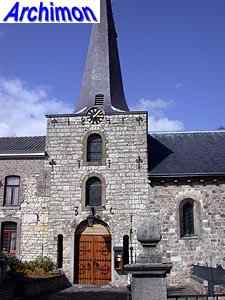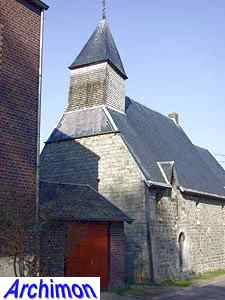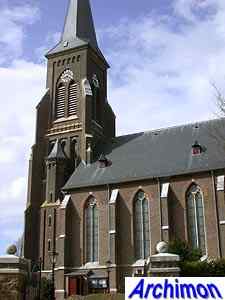
Vaals municipality / Gemeente Vaals (L)
Vaals
was first mentioned in 1041, but the fertile area was inhabited much
earlier than that. After the fall of the Franconian empire Vaals
successively belonged to the duchy of Limburg, the diocese of Liège and
the duchy of Brabant, the latter of which itself was absorbed by
Burgundy and the Spanish empire. In 1662 Vaals became property of the
Republic of the United Netherlands. Cooperation with the cloth industry
in the nearby German city of Aachen started a period of economic
prosperity. In ca. 1760 many protestants from that city fled to Vaals
when the political climate for them in Aachen worsened, including
several cloth-manufacturers. With the coming of the French in 1795 many
manufacturers returned to Aachen. In 1815 Vaals became part of the new
Kingdom of the Netherlands. The unfavourable location of Vaals near the
German border resulted in the end of the cloth-industry. From 1830
until 1839 the town was part of Belgium, after which it returned to the
Netherlands.
Vaals
is the center of a municipality to which also belong the villages
Lemiers, Vijlen and Holset and several hamlets, including
Mamelis.
De oudste vermelding van Vaals stamt uit 1041, maar het vruchtbare gebied was al veel eerder bewoond. Na de val van het Frankische rijk behoorde Vaals tot het hertogdom Limburg, het bisdom Luik en het hertogdom Brabant, waarvan de laatste zelf werd geabsorbeerd door Bourgondië en het Spaanse rijk. In 1662 werd Vaals bezit van de Republiek der Verenigde Nederland. Samenwerking met de lakennijverheid in de nabijgelegen Duitse stad Aken leidde tot een periode van economische voorspoed. Rond 1760 vluchtten vele protestanten uit die stad naar Vaals omdat het politieke klimaat in Aken voor hen verslechterde, waaronder een aantal textielfabrikanten. Met de komst van de Fransen in 1795 keerden veel fabrikanten terug naar Aken. In 1815 werd Vaals een deel van het nieuwe Koninkrijk der Nederlanden. De ongunstige ligging van Vaals nabij de Duitse grens heeft geleid tot het einde van de textielindustrie. Van 1830 tot 1839 behoorde de stad tot België, en keerde daarna terug bij Nederland. Vaals is het centrum van een gemeente waartoe ook de dorpen Lemiers, Vijlen en Holset behoren, alsmede verschillende gehuchten als Mamelis.
 The
reformed church dates from 1672, although the
tower is much older, dating from the 13th century. This tower was part
of a church that under the rule of the Republic was used by both
catholics and protestants. The increasing number of protestants made a
seperate church necessary, which was build square on the old one.
The catholics replaced the old church in 1752. The last
catholic church on this location was demolished in 1967, long after the
catholics had built a new church elsewhere in the town.
The
reformed church dates from 1672, although the
tower is much older, dating from the 13th century. This tower was part
of a church that under the rule of the Republic was used by both
catholics and protestants. The increasing number of protestants made a
seperate church necessary, which was build square on the old one.
The catholics replaced the old church in 1752. The last
catholic church on this location was demolished in 1967, long after the
catholics had built a new church elsewhere in the town.
Location: Kerkstraat 47
De hervormde kerk dateert uit 1672, hoewel de toren al uit de 13e eeuw stamt. Deze toren maakte deel uit van een kerk die onder het bewind van de Republiek als simultaankerk werd gebruikt door zowel katholieken als protestanten. Het toenemend aantal protestanten maakte een eigen kerk noodzakelijk, die dwars op de oude werd gebouwd. De katholieken vervingen de oude kerk in 1752. De laatste katholieke kerk op deze locatie werd afgebroken in 1967, lang nadat de katholieken elders in de stad een nieuwe kerk hadden gebouwd.
Locatie: Kerkstraat 47

The former Lutheran church dates from 1736 and was built for refugees from Aachen. It's an octagonal building with two storeys. It was designed by either an architect Von Littich or by Johann Josef Couven.
Location: Von Clermontplein 1
De voormalige Lutherse kerk dateert uit 1736 en werd gebouwd voor vluchtelingen uit Aken. Het is een achthoekig gebouw met twee verdiepingen. Het werd ontworpen door ofwel een zekere architect Von Littich of door Johann Josef Couven.
Locatie: Von Clermontplein 1

The Roman Catholic church H. Paulus Bekering was built in 1892-1893 and was designed by J.H.J. Kayser in a neo-Gothic style that incorporated elements of Gothicism in northern Germany. A typical feature are the glazed bricks.
Location: Kerkstraat 27
De rooms-katholieke kerk H. Paulus Bekering is gebouwd in 1892-1893 en werd ontworpen door J.H.J. Kayser in een neogotische stijl waarin invloeden uit de Noordduitse gotiek zijn verwerkt. Een typisch kenmerk zijn de geglazuurde bakstenen.
Locatie: Kerkstraat 27
 A
bit outside Vaals in the 18th century farm De Esch was built. In 1897
it became a monastery of the Camilian order, for which this
neo-Romanesque chapel was built in 1908. The
architect was J. Jorna.
A
bit outside Vaals in the 18th century farm De Esch was built. In 1897
it became a monastery of the Camilian order, for which this
neo-Romanesque chapel was built in 1908. The
architect was J. Jorna.
Location: Eschberg 7
Iets buiten Vaals werd in de 18e eeuw de boerderij De Esch gebouwd. In 1897 werd het een klooster van de Camilianenorde, waarvoor in 1908 deze neoromaanse kapel werd gebouwd. De architect was J. Jorna.
Locatie: Eschberg 7
Holset

The H.H. Lambertus en Genoveva is
a largely 12th-century Romanesque church but was restored
in 1884-1887 by J.H.J. Kayser, who added a chapel. The church was
entirely built of natural stone.
Location: Holset 64
De H.H. Lambertus en Genoveva is een grotendeels 12de-eeuwse romaanse kerk, maar werd in 1884-1887 gerestaureerd door J.H.J. Kayser die er een kapel aan toevoegde. De kerk werd volledig gebouwd van natuursteen.
Locatie: Holset 64
Lemiers

Despite
its 13th or 14th century choir
and several later changes, is the 11th or 12th century St. Catharina a
good, and the only complete, example of the earliest type of stone
church known to The Netherlands; a small one-aisled church in
Romanesque style.
Location: Oud Lemiers 16
Ondanks een koor uit de 13de of 14de eeuw en enkele veranderingen daarna, is de 11e of 12e eeuwse St. Catharina een goed, en het enige complete, voorbeeld van het vroegste type stenen kerk dat in Nederland bekend is; een kleine eenbeukige kerk in romaanse stijl.
Locatie: Oud Lemiers 16

Since the St. Catharina was too small, a new church was built at the side of the road from Maastricht to Vaals in 1895-1896. This H.H. Catharina en Lucia is a neo-Romanesque building, designed by J. Jorna.
Location: Rijksweg 83
Omdat de St. Catharina te klein was, werd in 1895-1896 een nieuwe kerk gebouwd langs de weg van Maastricht naar Vaals. Deze H.H. Catharina en Lucia is een neoromaans gebouw, ontworpen door J. Jorna.
Locatie: Rijksweg 83
Vijlen

Standing on the top of a hill, the St. Martinus of Vijlen is the highest located church of The Netherlands. The neo-Gothic church was designed by C. Weber and built in 1860-1862, although the tower was not added until 1872.
Location: Vijlenberg 72
Staand op de top van een heuvel is de St. Martinus van Vijlen de hoogst gelegen kerk van Nederland.De neogotische kerk werd ontworpen door C. Weber en gebouwd in 1860-1862, hoewel de toren werd pas in 1872 werd toegevoegd.
Locatie: Vijlenberg 72
Mamelis

The Benedictine abbey St. Benedictusberg was built between 1921 and 1923 and was designed by D. Böhm, a famous German church architect.
Location: Mamelis 39
De Benedictijner abdij St. Benedictusberg werd gebouwd tussen 1921 en 1923 en werd ontworpen door D. Böhm, een beroemde Duitse kerk architect.
Locatie: Mamelis 39

The abbey church is a modern building completed in 1968. It was designed by monk-architect Dom H. van der Laan, leader of the Bossche School movement, who lived in the abbey for several decades and added several more constructions to the complex.
Location: Mamelis 39
De abdijkerk is een modern gebouw dat in 1968 werd voltooid. Het werd ontworpen door monnik-architect Dom H. van der Laan, leider van de Bossche School, die al tientallen jaren in de abdij woonde en nog meer gebouwen aan het complex toevoegde.
Locatie: Mamelis 39